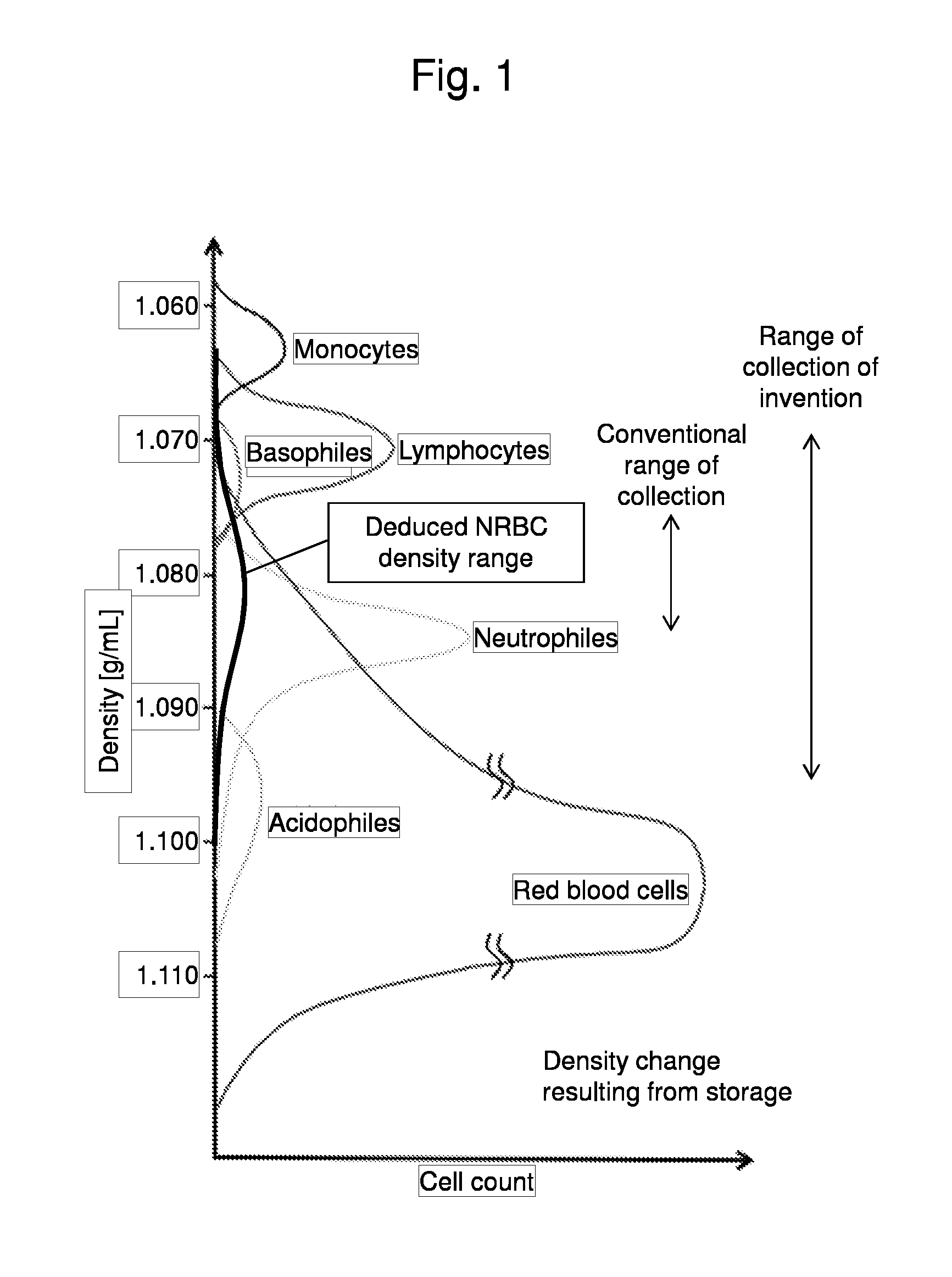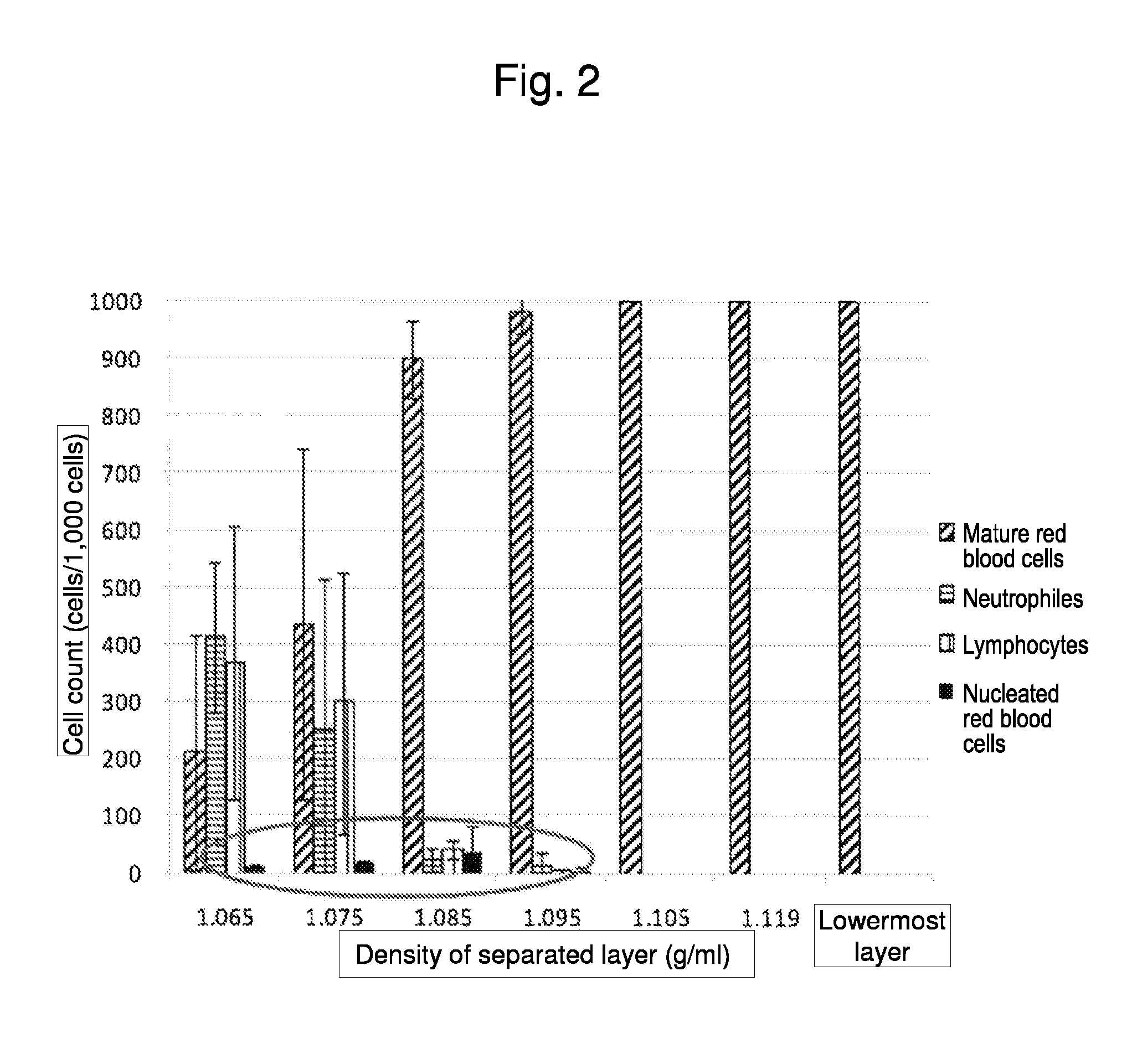Method for collecting nucleated red blood cells via density-gradient centrifugation utilizing changes in blood cell density
a technology of density gradient and red blood cell density, which is applied in the field of cell separation, can solve the problems of increasing the number of white blood cells contaminating such fractions, interfering with subsequent procedures, and white blood cells remaining in a fraction containing abundant nucleated red blood cells after centrifugation, so as to reduce the total cell count, and reduce the risk of misdiagnosis
- Summary
- Abstract
- Description
- Claims
- Application Information
AI Technical Summary
Benefits of technology
Problems solved by technology
Method used
Image
Examples
example 1
Determination of Nucleated Red Blood Cell Density
[0081]In Example 1, the umbilical cord blood containing large quantities of nucleated red blood cells was used as a sample. The “umbilical cord blood” is the blood of a fetus collected from the umbilical cord at the time of birth, and it contains large quantities of nucleated red blood cells. In order to inspect the effectiveness of the method of the present invention, the umbilical cord blood containing large quantities of fetal nucleated red blood cells was used, instead of the peripheral blood obtained from a pregnant woman containing small quantities of fetal nucleated red blood cells. The number of nucleated red blood cells in the maternal blood, which is the peripheral blood obtained from a pregnant woman, is lower than that in the umbilical cord blood. According to the method of concentrating and collecting nucleated red blood cells from the umbilical cord blood sample, nucleated red blood cells can be concentrated and collecte...
example 2
Separation of Nucleated Red Blood Cells Using Percoll Solution And Polymorphprep Solution
Preparation of Percoll Solution and Polymorphprep Solution
[0083]A Percoll stock solution (4.848 ml, 1.132 g / ml, GE Healthcare Biosciences, Cat. No: 17-0891-01), 1.000 ml of 1.5 M NaCl, and 4.152 ml of sterile water were mixed (total amount: 10.000 ml), an isosmotic Percoll solution (280 mOsm) having a density of 1.070 g / ml was prepared, 6.742 ml of a Percoll stock solution, 1.000 ml of 1.5 M NaCl, and 2.258ml of sterile water were mixed (total amount: 10.000 ml), and an isosmotic Percoll solution having a density of 1.095g / ml was prepared.
[0084]A Polymorphprep stock solution (8.348 ml, 1.113 g / ml, AXIS-SHIELD, Cat. No: 1114683) and 1.652 ml of 0.9% NaCl were mixed (total amount: 10.000 ml), and a Polymorphprep (PMP) solution having a density of 1.095 g / ml was prepared.
[0085]An agreement was obtained from a pregnant woman at the time of delivery and the umbilical cord blood after delivery was use...
example 3
Separation of Nucleated Red Blood Cells Using Percoll Solution and NaCl Solution
Preparation of Isosmotic Percoll Solution and Hypertonic Percoll Solution
[0098]A Percoll stock solution (4.848 ml), 1.000 ml of 1.5 M NaCl, and 4.152 ml of sterile water were mixed (total amount: 10.000 ml) to prepare an isosmotic Percoll solution (280 mOsm) having a density of 1.070 g / ml. A Percoll stock solution (6.742 ml), 1.000 ml of 1.5 M NaCl, and 2.258 ml of sterile water were mixed (total amount: 10.000 ml) to prepare an isosmotic Percoll solution having a density of 1.095 g / ml.
[0099]Further, 6.529 ml of a Percoll stock solution, 1.470 ml of 1.5 M NaCl, and 2.0011 ml of sterile water were mixed (total amount: 10.000 ml) to prepare a hypertonic Percoll solution (420 mOsm) having a density of 1.095 g / ml.
[0100]An agreement was obtained from a pregnant woman at the time of delivery, and the umbilical cord blood after delivery was used as a sample.
Separation with Isosmotic Percoll Solution
[0101]The um...
PUM
| Property | Measurement | Unit |
|---|---|---|
| Density | aaaaa | aaaaa |
| Density | aaaaa | aaaaa |
| Substance count | aaaaa | aaaaa |
Abstract
Description
Claims
Application Information
 Login to View More
Login to View More - R&D
- Intellectual Property
- Life Sciences
- Materials
- Tech Scout
- Unparalleled Data Quality
- Higher Quality Content
- 60% Fewer Hallucinations
Browse by: Latest US Patents, China's latest patents, Technical Efficacy Thesaurus, Application Domain, Technology Topic, Popular Technical Reports.
© 2025 PatSnap. All rights reserved.Legal|Privacy policy|Modern Slavery Act Transparency Statement|Sitemap|About US| Contact US: help@patsnap.com



